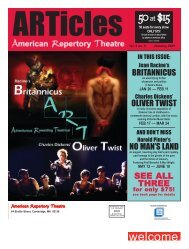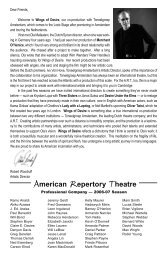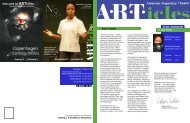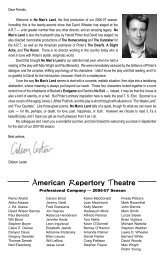CARMEN THE KEENING - American Repertory Theater
CARMEN THE KEENING - American Repertory Theater
CARMEN THE KEENING - American Repertory Theater
You also want an ePaper? Increase the reach of your titles
YUMPU automatically turns print PDFs into web optimized ePapers that Google loves.
The Colombian War in the Theatre:<br />
Humberto Dorado’s <strong>THE</strong> <strong>KEENING</strong> by Guillermo González Uribe<br />
T<br />
he Keening is an intense monologue, nearly<br />
two hours of breathlessness. The work<br />
illustrates violence as one lives it in<br />
Colombia, displayed with unusual drama and emotion.<br />
The story unfolds in a town along Colombia’s<br />
northern coast, where a paramilitary landholder<br />
exercises power. The work relates how absolute<br />
power in the hands of bloodthirsty authorities<br />
results in every sort of outrage, how whoever dares<br />
to contradict such power is beyond salvation, even<br />
family members or friends of the powerful; how<br />
paramilitary power has spread under the protecting<br />
hand of regular state forces. It allows us to see how<br />
both forces trample upon the civil population; in<br />
areas that serve as corridors for the passage of<br />
men with guns, one group or another will seek the<br />
help of civilians, while other groups will attack civilians<br />
under suspicion of collaborating with still other<br />
groups. War leaves nothing untouched. It dissolves<br />
family bonds. It produces acts of unthinkable cruelty<br />
even in times of peace, and it distorts the economic,<br />
social, and political order.<br />
The Keening is a monologue that causes us<br />
to feel deep sorrow. It is a raw and intense work;<br />
through the memories of one woman, who is a<br />
mother, a spouse, a lover, and a supportive friend,<br />
we approach the gates of<br />
horror, of hell, in order to<br />
contemplate the naked<br />
truth. We see the proof of<br />
drug money’s corrupting<br />
influence on communities<br />
and families, an influence<br />
that leads to massacre and<br />
assassination. We see how<br />
absolute power leads to<br />
coercion, coercion to outrage<br />
and human depredation.<br />
The Keening is a work<br />
that leaves us shaken,<br />
forced to confront realities<br />
that the mass media is<br />
unable to penetrate. It is a<br />
cry and an appeal. It is the<br />
reality of war in Colombia,<br />
offered up naked to the eye.<br />
Violence is one of the<br />
fundamental themes of art<br />
in Colombia. García<br />
Márquez in literature,<br />
Fernando Botero in painting,<br />
and Víctor Gaviria in<br />
filmmaking are some of the<br />
best-known artists who<br />
have taken up this theme in<br />
their works. In theater, the<br />
seventies and eighties saw<br />
the rise of a vigorous movement<br />
with a political edge.<br />
Works like Guadalupe<br />
años 50, a collective creation<br />
of the group La<br />
Candelaria, directed by<br />
Santiago García, and The<br />
Agony of the Deceased,<br />
written by Esteban Navajas<br />
and brought to the stage by<br />
Teatro Libre de Bogotá,<br />
crossed boundaries and became icons of the marriage<br />
of art and politics. Humberto Dorado comes<br />
from precisely this same tradition. He was an actor<br />
at the Teatro Libre, and later a film director, a television<br />
actor, a writer of short stories, and the author<br />
of The Keening.<br />
In order to delve into the work in question and<br />
its setting, Colombian reality, it’s worthwhile to ask<br />
ourselves the following questions: Why, in a country<br />
so privileged by nature—with three mountain<br />
ranges, part of the Amazon rainforest, coasts on<br />
two oceans, every type of climate at every time of<br />
year, from 0 to over 100 degrees—is there more<br />
violence than almost anywhere else in the world?<br />
Why does Colombia have the oldest guerrilla fighter<br />
on the planet, Manuel Marulanda Vélez, also<br />
known as “Tirofijo”, commander of the<br />
Revolutionary Armed Forces of Colombia (FARC),<br />
who has spent the last fifty years in arms? Why, at<br />
the northern extremity of South America, listed as<br />
one of the most biodiverse regions on the planet,<br />
are there daily massacres, selective assassinations,<br />
massive human displacement, the destruction<br />
and seizure of cities, towns, and populations at<br />
the hands of paramilitaries, guerillas, and the regular<br />
army? Where did this violence come from?<br />
Why does it continue? How does it manifest itself?<br />
Origins of the Violence<br />
As in many countries, the development of<br />
Colombia as a nation was characterized by violence.<br />
For various reasons, however, Colombia<br />
has been unable to overcome that violence. Its origins<br />
can be traced back to the period of the bloody<br />
conquest of the Americas in the 16 th century. The<br />
area that is now Colombia was occupied by a variety<br />
of autonomous and independent indigenous<br />
communities that were distinct from the two great<br />
precolombian empires. The Aztec of Central and<br />
North America; and the Inca, whose axis lay in<br />
what is now Peru, both possessed centralized, vertical<br />
and hierarchical governments. The conquest<br />
of these empires also took its<br />
bloody course, but once the<br />
rulers had submitted, it was<br />
easier to dominate the populace.<br />
In Colombia it became<br />
necessary to conquer and<br />
reconquer, with excessive cruelty<br />
and continuous bloodshed,<br />
each and every indigenous<br />
community on an individual<br />
basis (1) . Later came the<br />
bloody wars of independence,<br />
which installed in power a class<br />
of creole leaders, bound to<br />
their own interests rather than<br />
those of society, and immersed<br />
in internal feuds that have produced<br />
dozens of civil wars throughout the country’s<br />
barely 200 years of independence. Colombia<br />
is an explosive combination: the factions of a rapacious<br />
leadership that is unconcerned with the<br />
country and that has gone unrelieved for 200 years<br />
exist alongside independent, autonomous, and<br />
rebellious factions.<br />
Recent Violence<br />
The more recent origins of violence date from<br />
the 1950s, when fighting between the two traditional<br />
parties, the Liberals and the Conservatives,<br />
led to egregious bloodshed in the countryside and<br />
The Keening<br />
is a work that<br />
confronts realities that<br />
the mass media is<br />
unable to penetrate.<br />
in the cities, and culminated in the assassination of<br />
political leader Jorge Eliécer Gaitán, who embodied,<br />
for the first time ever, the alternative of popular<br />
power. Radicalized liberal guerrillas, who did not<br />
believe in the peace offered by the traditional sectors<br />
of power, established the first leftist guerrilla<br />
organization, the FARC. Later, in the sixties and<br />
seventies, other guerrilla groups arose. In the<br />
eighties drug traffickers, allied with urban and rural<br />
business interests and the regular forces of the<br />
state, gave birth to the first right-wing paramilitary<br />
groups. The paramilitaries seek to combat the<br />
guerrillas and to capture their zones of influence,<br />
without even a thought for the methods used in<br />
order to maintain the political<br />
and social status quo.<br />
What Colombia endures<br />
today is a conflict whose protagonists<br />
are paramilitaries,<br />
guerrillas, and the state armed<br />
forces. Caught in the middle is<br />
a civil population that is disrespected,<br />
manipulated, and<br />
threatened by all the parties<br />
involved. The conflict is funded<br />
through drug trafficking,<br />
which corrupts everything it<br />
touches. Such are the paradoxes<br />
of life that the coca leaf,<br />
which for the indigenous people<br />
of South America was part<br />
of a fundamental ritual, in the 19 th century was<br />
processed by westerners into cocaine, the same<br />
product which under the current conditions,<br />
because it is illegal, reaps the greatest profits possible<br />
on the international market. Colombia is the<br />
world’s largest producer of illegal drugs. It is a<br />
country where social inequalities, intolerance, and<br />
drug trafficking money have created a deinstitutionalized<br />
nation where power is the preserve of<br />
those with guns and money; as long as these<br />
drugs are illegal, the war in Colombia will be difficult<br />
to end, since the resources they contribute to<br />
the men with guns are almost inexhaustible. The<br />
AUC paramilitaries in a jungle camp in southern Colombia, 2001.




![Wild Swans Program [pdf] - American Repertory Theater](https://img.yumpu.com/49339866/1/167x260/wild-swans-program-pdf-american-repertory-theater.jpg?quality=85)

![Press Release: Trojan Barbie [pdf] - American Repertory Theater](https://img.yumpu.com/47571290/1/190x245/press-release-trojan-barbie-pdf-american-repertory-theater.jpg?quality=85)
![Articles issue as 4_2 [pdf] - American Repertory Theater](https://img.yumpu.com/45053160/1/190x249/articles-issue-as-4-2-pdf-american-repertory-theater.jpg?quality=85)

![Three Pianos Program [pdf] - American Repertory Theater](https://img.yumpu.com/41616353/1/167x260/three-pianos-program-pdf-american-repertory-theater.jpg?quality=85)
![Three Sisters [pdf] - American Repertory Theater](https://img.yumpu.com/40969361/1/190x245/three-sisters-pdf-american-repertory-theater.jpg?quality=85)


![Program: Sleep No More [pdf] - American Repertory Theater](https://img.yumpu.com/24629394/1/167x260/program-sleep-no-more-pdf-american-repertory-theater.jpg?quality=85)
![Porgy and Bess Program [pdf] - American Repertory Theater](https://img.yumpu.com/24481101/1/167x260/porgy-and-bess-program-pdf-american-repertory-theater.jpg?quality=85)
![Program: Carmen [pdf] - American Repertory Theater](https://img.yumpu.com/24481072/1/190x245/program-carmen-pdf-american-repertory-theater.jpg?quality=85)
